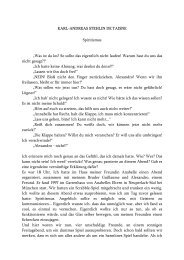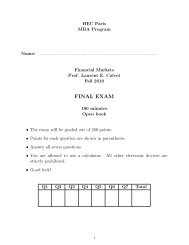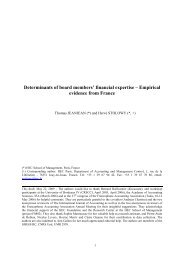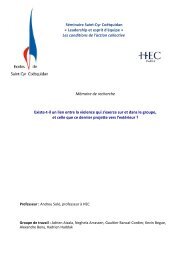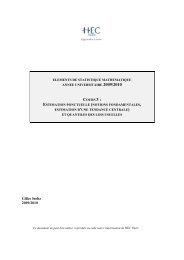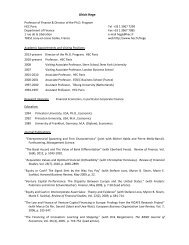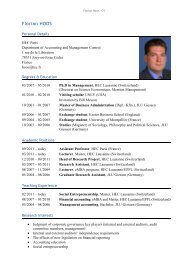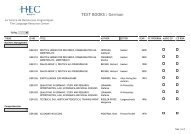Multifractality of US Dollar/Deutsche Mark Exchange Rates - Studies2
Multifractality of US Dollar/Deutsche Mark Exchange Rates - Studies2
Multifractality of US Dollar/Deutsche Mark Exchange Rates - Studies2
You also want an ePaper? Increase the reach of your titles
YUMPU automatically turns print PDFs into web optimized ePapers that Google loves.
trading time as the cumulative distribution function (“c.d.f.”) <strong>of</strong> a statistically self-similar random<br />
measure. For interested readers, this argument is presented in Appendix 9.1. Otherwise, seasonal<br />
adjustment can be viewed simply as a stationarity requirement.<br />
This complication is addressed by applying a seasonal adjustment filter 11 that reduces the<br />
seasonal component in the data. The seasonally modified version <strong>of</strong> the MMAR is written<br />
ln P (t) =BH {θ [SEASn(t)]} ,<br />
where SEASn denotes the n th seasonal adjustment filter among the several that we employ. 12<br />
The basic idea is that time is expanded during typically active periods <strong>of</strong> the week, and contracted<br />
during typically slow periods. The expansions and contractions are restricted to maintain a constant<br />
amount <strong>of</strong> total time, i.e. 604, 800 seconds in a week.<br />
Even for established time series models, seasonal adjustment is a delicate issue. (See the survey<br />
by Ghysels, 1994.) Optimal procedures, in the sense <strong>of</strong> Grether and Nerlove (1970), are thus beyond<br />
the scope <strong>of</strong> the present paper, and should be investigated separately. Instead, we choose a range<br />
<strong>of</strong> imperfect, but reasonable, seasonal adjustment filters. Some have the merit <strong>of</strong> predictability in<br />
whether they under-adjust or over-adjust for the seasonal component. This range allows us to test<br />
robustness <strong>of</strong> results to reasonable variation in the seasonal adjustment method.<br />
To simplify presentation, the results in Sections 3 and 5 use a single seasonal adjustment filter.<br />
Section 6 separately investigates the issue <strong>of</strong> robustness, and presents results for the other four<br />
filters. The filter used for the main results is SEAS2 which deforms time to smooth variation in<br />
average absolute returns over fifteen minute intervals <strong>of</strong> the week.<br />
A broader view <strong>of</strong> multifractality is simply the presence <strong>of</strong> multiple Hölderexponents,asinCFM.Whilewehave<br />
not fully developed this viewpoint, one would proceed by presenting multifractality as an asymptotic, and thus less<br />
restrictive, requirement. This definition would permit seasonality, since seasonality can typically be viewed as a<br />
smooth transformation that affects prefactors, but not Hölder exponents. As long as prefactors are well behaved, the<br />
scaling properties as △t → 0 are not affected. This idea may be further developed in the future, but does not seem<br />
to present significant advantages in empirical work at the present time.<br />
11<br />
The term “filter” as used here simply means the data are “treated in a particular way before they are analyzed”<br />
(Hamilton, 1990, p.63).<br />
12<br />
Hereafter, we specify the seasonal filter in text and graphs, and drop this notation from future equations. Construction<br />
<strong>of</strong> the seasonal adjustment filters is discussed in Appendix 9.2.<br />
9



